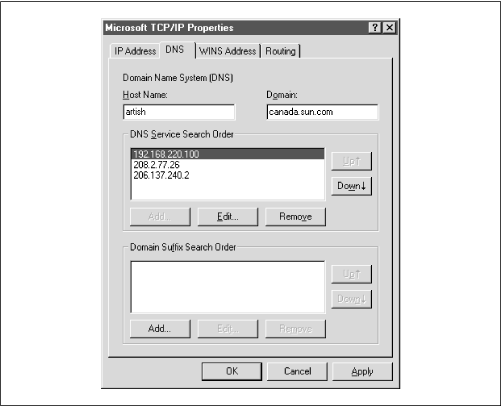Next we go to the tab for DNS, as shown in
Figure 3.23. This brings up the DNS panel.

The Domain Name System (DNS) is responsible for translating human-readable computer names such as
atrish.example.com into IP addresses such as 192.168.236.10. There are two ways to accomplish this on a NT machine. First, you can specify a DNS server to do the translation for you, or you can keep a local list of name/address pairs for your workstation to refer to.
For a LAN that's not on the Internet, the list of possible hosts is typically small and well known, and may be kept in a file locally. Networks that are connected to the Internet typically use DNS service since it isn't possible to guess ahead of time what addresses you might be accessing out on the net. If you are in doubt as to whether a DNS server is being used, or what its address might be, look at the file
/etc/resolv.conf on your Samba server: any machine using DNS will have this file. It looks like the following:
#resolv.conf
domain example.com
nameserver 127.0.0.1
nameserver 192.168.236.20
In this example, the first nameserver in the list is 127.0.0.1, which indicates that the Samba server is also a DNS server for this LAN.[] In that case, you would use its network IP address (not 127.0.0.1, its localhost address) when filling in the DNS Configuration dialog box. Otherwise, use the other addresses you find in the lines beginning with
nameserver. Try to select ones on your own network. Any name servers listed in
/etc/resolv.conf should work, but you'll get better performance by using a server nearby.
Finally, enter the machine name once more, making sure that it's the same one listed in the Identification tab of the Network dialog box (before the NetBIOS name). Also, enter the DNS domain on which this machine resides. For example, if your workstation has a domain name such as
example.com, enter it here. You can safely ignore the other options.
